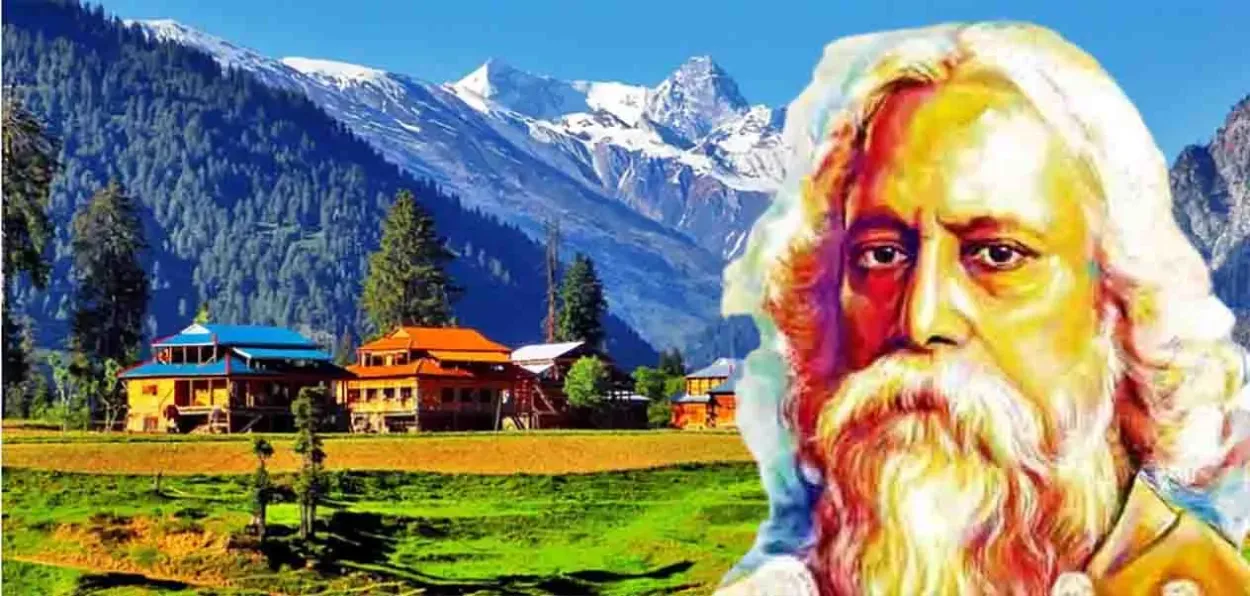
Amir Suhail Wani
Rabindranath Tagore, poet, philosopher, and polymath, held a profound connection with Kashmir. His visits to the Valley in the early 20th century left an indelible mark on his work and thoughts. For Tagore, Kashmir was not merely a geographical location; it represented a confluence of beauty, spirituality, and cultural richness that resonated deeply with his artistic sensibilities.
Tagore first visited Kashmir in 1913, after he had received the Nobel Prize in Literature for his collection "Gitanjali." His journey to Kashmir was both a retreat and an exploration and a chance to reconnect with nature. The valley's majestic mountains, lush gardens, and shimmering waters captivated him, prompting reflections on beauty and the spiritual essence of existence. In his letters and writings of that period, Tagore expressed his awe at Kashmir’s natural splendour and its capacity to evoke emotional and philosophical responses.
Kashmir's enchanting environment became a backdrop for Tagore's exploration of themes such as love, loss, and the relationship between humanity and nature. He found a unique tranquility in the valley, which allowed him to engage deeply with his thoughts and emotions. The landscapes served as a canvas for his imagination, leading to the creation of several poems and prose pieces that celebrated the harmony between nature and the human spirit. For Tagore, nature was not just a physical space; it was a living entity that could inspire and nurture the soul.
The cultural richness of Kashmir, with its historical syncretism and diverse influences, further intrigued Tagore. He was captivated by the region's artistic traditions, particularly its poetry, music, and crafts. The presence of Sufi mysticism, which permeated Kashmiri culture, resonated with Tagore's philosophical inquiries into the nature of existence and the divine. He appreciated the spiritual depth of Kashmiri poetry and its ability to express complex emotions and experiences. This engagement with local culture allowed Tagore to forge a deeper connection with the people of Kashmir, enriching his understanding of their world.
Tagore's interactions with local artists and intellectuals highlighted his belief in the universality of art. He saw in Kashmir a microcosm of humanity, where diverse influences coexisted harmoniously. This belief was instrumental in shaping his vision of art as a bridge that transcends cultural and geographical boundaries. Through his writings, he explained that beauty and truth could be found in all corners of the world and that the artistic spirit was a unifying force that could foster understanding and empathy among people.
In addition to its natural beauty and cultural richness, Kashmir held a symbolic significance for Tagore as a representation of the larger human experience. The valley, often referred to as “Paradise on Earth,” was a place where he could reflect on the complexities of life, including themes of conflict and the quest for peace. At a time when India was grappling with colonial rule and communal tensions, Tagore's encounters in Kashmir reminded him of the need for unity and understanding among diverse communities. He believed that art could play a pivotal role in bridging divides and fostering a sense of shared humanity.
Tagore’s poetry often mirrored the experiences he encountered in Kashmir, where he was inspired to write works that expressed his deep yearning for beauty and spiritual fulfillment. His verses evoke the lush landscapes and vibrant colors of the valley, painting vivid images that linger in the reader's mind. The experience of being surrounded by nature’s grandeur allowed him to articulate his thoughts on love and longing, weaving them into the fabric of his poetic expression. His relationship with Kashmir was thus both personal and universal, embodying a search for meaning that resonated with people across different cultures and epochs.
Moreover, Tagore's connection to Kashmir extended beyond aesthetic appreciation. He recognized the valley's fragility in the face of political and social upheaval. His writings often hinted at a sense of urgency regarding the preservation of Kashmir's beauty and its cultural heritage. He advocated for a world where nature and humanity coexisted peacefully, a vision that felt particularly poignant given the tumultuous history of the region. Tagore's reflections on Kashmir served as a reminder of the importance of cherishing and protecting the natural world, as well as the cultural identities that enrich the human experience.
In the decades following his visits, Kashmir would face significant turmoil, transforming from a serene landscape into a site of conflict and division. The changes in the region inevitably altered the perception of its beauty and tranquility. Tagore’s legacy, however, remains a testament to the power of art and culture to transcend such turmoil. His vision of Kashmir as a place of inspiration and spiritual awakening continues to resonate, encouraging future generations to seek beauty in the world and to embrace the values of understanding and empathy.
Rabindranath Tagore’s engagement with Kashmir was a profound exploration of beauty, culture, and humanity. The valley inspired him to articulate his thoughts on existence, art, and the interconnectedness of all life. His experiences in Kashmir reflect a deep appreciation for nature and an understanding of the complexities of human emotions, providing insights that remain relevant today.
ALSO READ: Ashram in south Kashmir on mission of 'man-making and nation-building’
As a symbol of harmony and artistic expression, Kashmir continues to be a source of inspiration for those who seek to explore the relationship between nature, culture, and the human spirit, echoing Tagore’s timeless quest for beauty and truth. His legacy invites us to cherish our landscapes and cultures, recognizing the shared humanity that binds us all.
